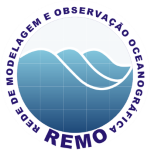Forecast date and time
Select a product
Meteograms Numerical models
Select the time of the available model rounds, the model, then the available areas will appear and then the location.
Settings
Use the controls below to increase and decrease speed and width of currents movement on the map.
In certain areas and times, the current may be at low speed. By increasing the speed and increasing the width, it is possible to better observe some phenomenons.
Use the control below to increase or decrease the player's loop time.
If it is on, at each zoom in or out, the system will increase or decrease the amount of displayed flows.
REMO
The Oceanographic Observation and Modeling Network (REMO) is a Brazilian effort in physical oceanography and operational oceanography conducted by a group of researchers, technicians and students associated with universities, research centers and the Brazilian Navy, funded by Petrobras and the National Agency of Petroleum, Natural Gas and Biofuels ( ANP).
The overall goal of REMO is the development of science and technology in physical oceanography, ocean modeling, observational oceanography and operational oceanography with data assimilation.

HYCOM Model
The Hybrid Coordinate Ocean Model (HYCOM) is a general ocean circulation model that evolved from the Miami Isopycnic-Coordinate Ocean Model (MICOM) developed by Rainer Bleck (2002) and colleagues. The numerical model solves primitive equation and general circulation and is used in several institutions for research purposes and for operational oceanographic forecasting. The main feature of HYCOM is the use of hybrid vertical coordinates, which may be pressure levels, isopicnal or sigma (terrain following). With the use of these hybrid coordinates it is possible to obtain more realistic results in simulations of ocean phenomena both in the open sea and in shallower regions. HYCOM is coded in Fortran, fully parallelized (MPI protocol) to run on high performance calculation servers. The model provides several outputs, highlighting current and temperature.
HYCOM-CHM runs on two grids with overlapping areas namely:
- Grid with 1/12 degree resolution spanning the entire Atlantic Ocean basin, with vertical resolution with 32 hybrid levels. Provides boundary conditions for the higher resolution grid;
- Grid with horizontal spatial resolution of 1/24 degree resolution and 32 hybrid vertical levels covering METAREA V. This grid incorporates, as a boundary condition, tidal harmonic components in order to model their propagation throughout the grid extension. The results of this grid are those presented on this page.
In order to maintain permanent adequacy of its results with the real values, a data assimilation process is associated with the modeling. This process consists of fitting the model results to data observed in the ocean. In this case, the observed data are: sea surface temperature, sea surface height and temperature and salinity vertical structure data obtained by drifters. The technique employed is statistical interpolation through the Ensemble Optimal Interpolation (EnOI) methodology, performed twice a week.
The modelo HYCOM-CHM is a regional application developed as part of the Oceanographic Modeling and Observation Network (REMO) project, a partnership between CHM, PETROBRAS, UFBA e UFRJ.